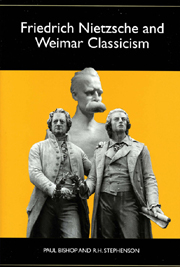Book contents
- Frontmatter
- Contents
- Dedication
- Acknowledgments
- A Note on Editions, Abbreviations, and Translations
- Introduction
- 1 Die Geburt der Tragödie and Weimar Classicism
- 2 The Formative Influence of Weimar Classicism in the Genesis of Zarathustra
- 3 The Aesthetic Gospel of Nietzsche's Zarathustra
- 4 From Leucippus to Cassirer: Toward a Genealogy of “Sincere Semblance”
- Appendix: The Composition of Zarathustra
- Bibliography
- Index
4 - From Leucippus to Cassirer: Toward a Genealogy of “Sincere Semblance”
Published online by Cambridge University Press: 05 February 2013
- Frontmatter
- Contents
- Dedication
- Acknowledgments
- A Note on Editions, Abbreviations, and Translations
- Introduction
- 1 Die Geburt der Tragödie and Weimar Classicism
- 2 The Formative Influence of Weimar Classicism in the Genesis of Zarathustra
- 3 The Aesthetic Gospel of Nietzsche's Zarathustra
- 4 From Leucippus to Cassirer: Toward a Genealogy of “Sincere Semblance”
- Appendix: The Composition of Zarathustra
- Bibliography
- Index
Summary
Freuet euch des wahren Scheins,
Euch des ernsten Spieles:
Kein Lebendiges ist ein Eins,
Immer ist's ein Vieles.
[Take delight in this true illusion,
In this serious play:
No living thing is One,
It is always Many.]
— Goethe, “Epirrhema”THERE IS MUCH IN THE long history of reflection on beauty in art and nature to support the view that Weimar Classicism is advocating a perennial aesthetic. It is not just that it has recently been claimed “that the aesthetic is […] the dynamic center of the whole speculative enterprise” of philosophy. There are also innumerable indications across the whole cultural spectrum, from theology to drama, to suggest a succession of anticipations of Goethe's and Schiller's position. For instance, Leucippus, the atomist materialist philosopher of the fifth century B.C.E., is reported to have taught that “true happiness is the purpose of the soul,” and that “happiness is procured by beautiful things.” Diogenes of Sinope, the Cynic philosopher of the fourth century B.C.E., is recorded as asking of someone: “Why do you live, if you are not concerned to make your life beautiful?” Moreover, the lure of semblance is attested to in the biblical Apocrypha, where King Solomon writes that “[men] are persuaded by appearances because what they see is so beautiful.”
- Type
- Chapter
- Information
- Friedrich Nietzsche and Weimar Classicism , pp. 151 - 196Publisher: Boydell & BrewerPrint publication year: 2004



